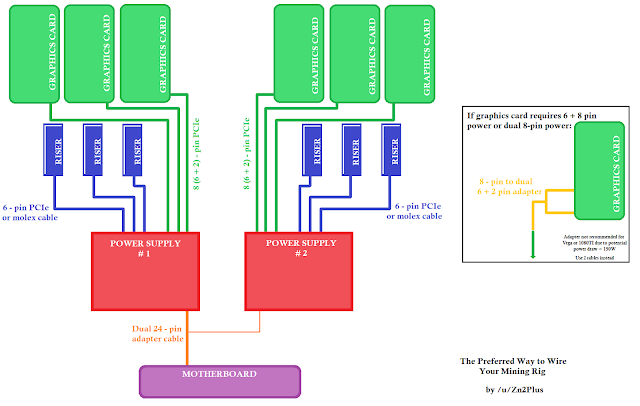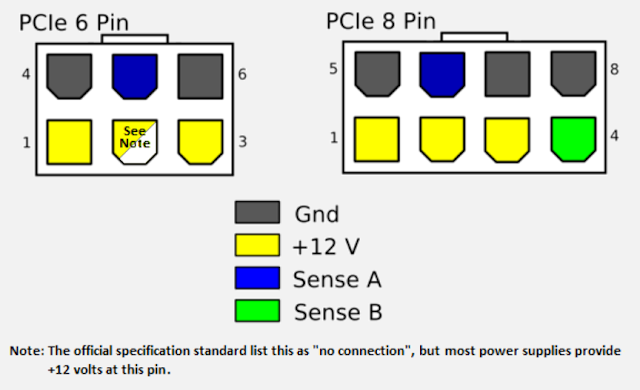Updated 15Mar2019
How to Power Your Cards and Risers
Certainly one of the most frustrating issues when first assembling a mining rig is knowing and adhering to cable powering specifications regarding your GPU Mining components. Crucial questions to ask: Do you have enough cable ports on the PSU? Do your cables have enough connectors? And how much power can each connector safely supply?
I've tackled the first two questions already. Are you choosing the right PSU?
So now we're looking into "How much power can each connector safely supply?"
It's ridiculous how much misleading information there in on the internet regarding this subject. The problem lies in the fact that PCI-SIG is the proprietary owner of the PCIe connector design and it costs a LOT to even view the PCIe connector electrical specifications. Furthermore, the specifications rate the maximum power draw far under what some armchair electricians *think* the maximum power draw should be given the gauge of the wires involved. Let's be responsible and break it down thoroughly to define the maximum power draw that the connection devices are intended to operate.
First let's be clear that PCI-SIG lists the maximum rating of its 6-pin PCI-e connector at 75 watts, and its 8-pin PCI-e connector at 150 watts. That is the safe rating, and you go any higher than that at your own risk.
Short and to the point, here we go:
How much power can each PSU cable safely supply?
| PCIe connections (and splitters) |
|---|
| Perif (molex) connections |
| SATA connections |
Putting it all together:
| Preferred way to wire a multi-PSU 6-card rig: |
|---|
Click on the diagrams to expand.
The Details!
Glad you asked. Here are the specifications of the above using publicly-available sourcing. If you want to dive in deep like me I strongly encourage you to pick up a copy of "Electronic Principles" by Dr. Albert Malvino and "Digital Electronics: Principles and Applications" by Roger Tokheim.
("Sense A / B" are grounds)
PCI-e 6- or 8-pin connector to GPU:
- Molex Mini-Fit Jr. Power Connector #45559-0002 (https://www.molex.com/pdm_docs/sd/455590002_sd.pdf)
- Amp Rating: up to 9A per connector if 2 circuits, up to 8A per connector if 3 circuits (https://www.molex.com/pdm_docs/ps/PS-45558-001-001.pdf)
Wiring capacity: https://www.bluesea.com/resources/1437 and http://assets.bluesea.com/files/resources/newsletter/images/DC_wire_selection_chartlg.jpg and http://circuitwizard.bluesea.com/#.
- Amp Rating: Up to 11A for 16 AWG wire, or up to 9A for 18 AWG wire
- Assuming: variable load, constant runtime, sheathed/insulated wire, wire insulation temperature rating 105°C, less than 6 ft circuit, max 3% voltage drop, up to 30°C ambient
- Very important for the user to confirm wire insulation temperature rating!
Example - if 80°C insulation rating: 16 AWG = 10A, 18AWG = 6A
Crimp Terminals:
- Interestingly, a max of 30 "mating cycles" for connector durability (https://www.molex.com/webdocs/datasheets/pdf/en-us/0039000090_CRIMP_TERMINALS.pdf)
- Amp Rating: Up to 9A per contact
As a general rule check both ends of your 6- or 8-pin PCI-e cable:
- If you see 5 pin terminals, there are 2 circuits = max 9A x 2 = 18A = 216W
- If you see 6+ pin terminals, there are 3 circuits* = max 8A x 3 = 24A = 288W
(*most likely 3 circuits, but confirm with PSU mfg or multimeter that 3 pins are +12V, 3 pins are ground)
As always, I hope this helps clear up some confusion and prevents your overloaded components from catching fire. Let's be responsible about this!





